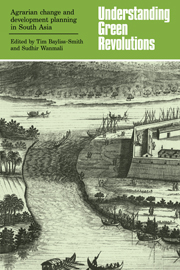Book contents
- Frontmatter
- Contents
- List of contributors
- Preface
- I Understanding Green Revolutions: an overview
- II Agrarian change at village level
- III Development planning and agrarian change
- 12 Rural-based models for rural development: the Indian experience
- 13 Planning and agrarian change in East Africa: appropriate and inappropriate models for land settlement schemes
- 14 Metropolitan expansion in India: spatial dynamics and rural transformation
- 15 Green Revolution and water demand: irrigation and ground water in Sri Lanka and Tamil Nadu
- 16 Social organisation and irrigation: ideology, planning and practice in Sri Lanka's settlement schemes
- 17 Environmental hazard and coastal reclamation: problems and prospects in Bangladesh
- 18 Beyond the Green Revolution: a selective essay
- Index
18 - Beyond the Green Revolution: a selective essay
Published online by Cambridge University Press: 25 May 2010
- Frontmatter
- Contents
- List of contributors
- Preface
- I Understanding Green Revolutions: an overview
- II Agrarian change at village level
- III Development planning and agrarian change
- 12 Rural-based models for rural development: the Indian experience
- 13 Planning and agrarian change in East Africa: appropriate and inappropriate models for land settlement schemes
- 14 Metropolitan expansion in India: spatial dynamics and rural transformation
- 15 Green Revolution and water demand: irrigation and ground water in Sri Lanka and Tamil Nadu
- 16 Social organisation and irrigation: ideology, planning and practice in Sri Lanka's settlement schemes
- 17 Environmental hazard and coastal reclamation: problems and prospects in Bangladesh
- 18 Beyond the Green Revolution: a selective essay
- Index
Summary
‘The Green Revolution’ is used so loosely to cover so much technological, agrarian and social change, in so many countries and zones, with so many ecological and social differences, that generalisations are precarious and subject to exceptions. Even if we focus on India, and on small farmers and labourers, as this essay does, almost every statement still deserves a paragraph of qualification. Even if the Green Revolution is narrowed to changes linked with new agricultural technology, taking the rapid rise in wheat production in Northwest India in the later 1960s as a classic case, there is still much room for debate and disagreement.
Views of the Green Revolution
Discussion is not made easier by the passionate assertion to which the Green Revolution has given rise. Little attention has been paid to the psychology and sociology of ignorance, prejudice and the selective use of evidence in analysing the Green Revolution; yet one obvious feature, with which it is salutary to start, has been the polarisation between those who have taken views which are positive and optimistic, and those whose views have been negative and pessimistic.
Those who have been positive and optimistic have included biological scientists involved in creating the new technologies. In the early days of the Green Revolution some of them saw an enormous potential for increased production. They were fired with enthusiasm and faith, excited at the way in which the new dwarf wheats and rices shifted yield potentials to new high levels.
- Type
- Chapter
- Information
- Understanding Green RevolutionsAgrarian Change and Development Planning in South Asia, pp. 362 - 380Publisher: Cambridge University PressPrint publication year: 1984
- 12
- Cited by



